Stream流是什么?
Stream(流)是一个来自数据源的元素队列并支持聚合操作
-
-
- 元素是特定类型的对象,形成一个队列。 Java中的Stream并不会存储元素,而是按需计算。
- 数据源 流的来源。 可以是集合,数组,I/O channel, 产生器generator 等。
- 聚合操作 类似SQL语句一样的操作, 比如filter, map, reduce, find, match, sorted等。
-
Stream 使用一种类似用 SQL 语句从数据库查询数据的直观方式来提供一种对 Java 集合运算和表达的高阶抽象。
Stream API可以极大提高Java程序员的生产力,让程序员写出高效率、干净、简洁的代码。
这种风格将要处理的元素集合看作一种流, 流在管道中传输, 并且可以在管道的节点上进行处理, 比如筛选, 排序,聚合等。
元素流在管道中经过中间操作(intermediate operation)的处理,最后由最终操作(terminal operation)得到前面处理的结果。
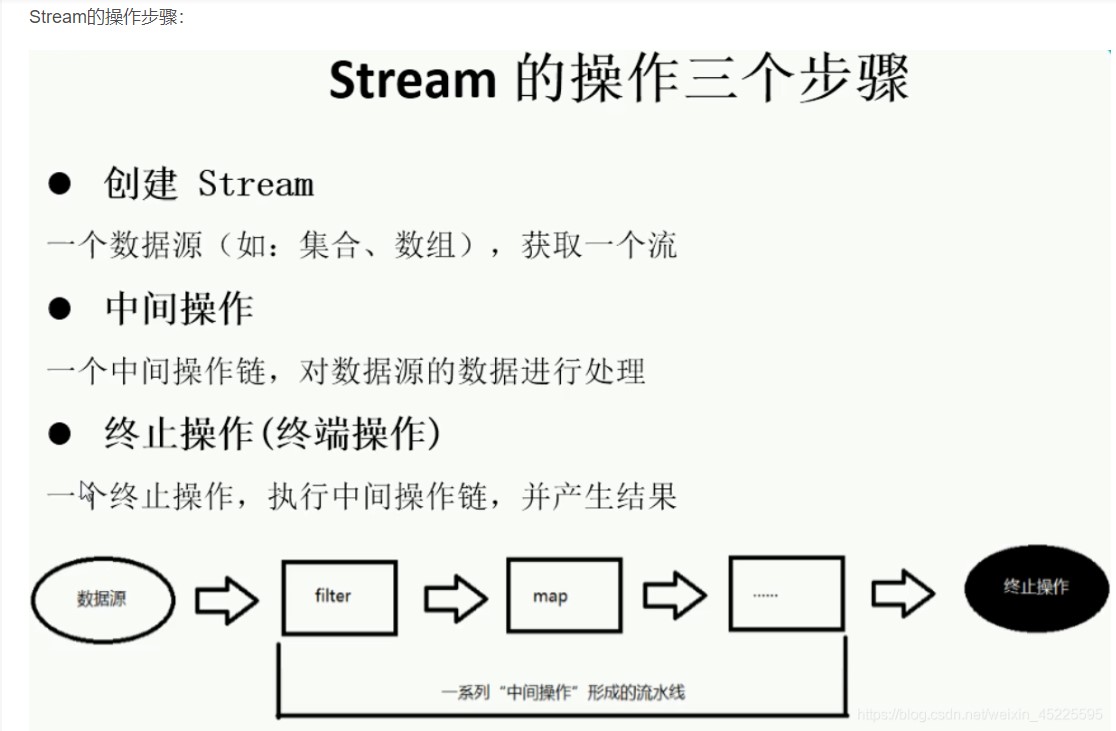
常用方法举例:
1.1筛选与切片:
中间操作:
-
-
- filter:接收 Lambda ,从流中排除某些元素
- limit:截断流,使其元素不超过给定数量
- skip(n):跳过元素,返回一个舍弃了前n个元素的流;若流中元素不足n个,则返回一个空流;与 limit(n) 互补
- distinct:筛选,通过流所生成的 hashCode() 与 equals() 取除重复元素
-
List<Employee> emps = Arrays.asList(
new Employee(101, "Z3", 19, 9999.99),
new Employee(102, "L4", 20, 7777.77),
new Employee(103, "W5", 35, 6666.66),
new Employee(104, "Tom", 44, 1111.11),
new Employee(105, "Jerry", 60, 4444.44)
);
@Test
public void test01(){
emps.stream()
.filter((x) -> x.getAge() > 35)
.limit(3) //短路?达到满足不再内部迭代
.distinct()
.skip(1)
.forEach(System.out::println);
}
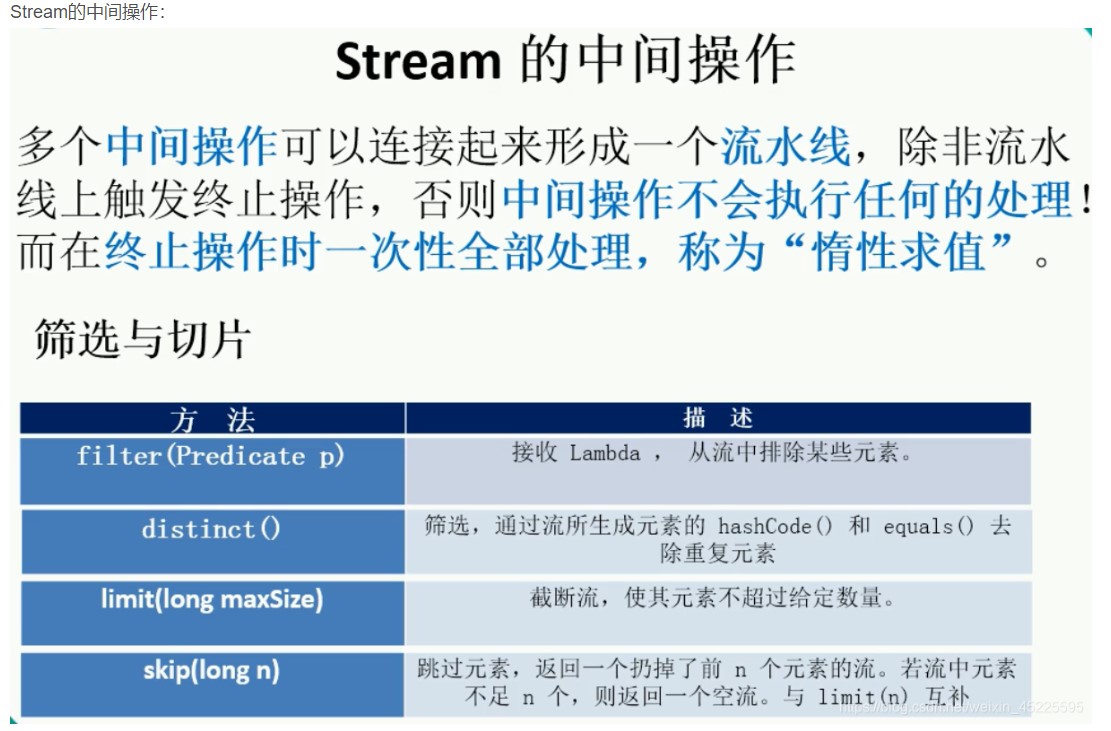
- 内部迭代:迭代操作由 Stream API 完成
- 外部迭代:我们通过迭代器完成
1.2映射:
- map:接收 Lambda ,将元素转换为其他形式或提取信息;接受一个函数作为参数,该函数会被应用到每个元素上,并将其映射成一个新的元素
- flatMap:接收一个函数作为参数,将流中每一个值都换成另一个流,然后把所有流重新连接成一个流
map和flatmap相当于add 和addAll的区别:
add:对("a", "b", "c")以一个集合的形式注入到新数组中 ( "1" ," 2 ", ("a", "b", "c"))
addAll: 把("a", "b", "c")以每个元素直接注入数组中( "1" ," 2 ","a", "b", "c")
map:
@Test
public void test02(){
List<String> list = Arrays.asList("a", "b", "c");
list.stream()
.map((str) -> str.toUpperCase())//变为A,B,C
.forEach(System.out::println);
}
flatMap:
public Stream<Character> filterCharacter(String str){
List<Character> list = new ArrayList<>();
for (char c : str.toCharArray()) {
list.add(c);
}
return list.stream();
}
@Test
public void test03(){
List<String> list = Arrays.asList("a", "b", "c");
Test02 test02 = new Test02();
list.stream()
.flatMap(test02::filterCharacter)
.forEach(System.out::println);
}
1.3排序:
-
- sorted():自然排序
- sorted(Comparator c):定制排序
Comparable:自然排序
@Test
public void test04(){
List<Integer> list = Arrays.asList(1,2,3,4,5);
list.stream()
.sorted() //comparaTo()
.forEach(System.out::println);
}
Comparator:定制排序
@Test
public void test05(){
emps.stream()
.sorted((e1, e2) -> { //compara()
if (e1.getAge().equals(e2.getAge())){
return e1.getName().compareTo(e2.getName());
} else {
return e1.getAge().compareTo(e2.getAge());
}
})
.forEach(System.out::println);
}
1.4查找/匹配:
终止操作:
-
-
- allMatch:检查是否匹配所有元素
- anyMatch:检查是否至少匹配一个元素
- noneMatch:检查是否没有匹配所有元素
- findFirst:返回第一个元素
- findAny:返回当前流中的任意元素
- count:返回流中元素的总个数
- max:返回流中最大值
- min:返回流中最小值
-
public enum Status {
FREE, BUSY, VOCATION;
}
@Test
public void test01(){
List<Status> list = Arrays.asList(Status.FREE, Status.BUSY, Status.VOCATION);
boolean flag1 = list.stream()
.allMatch((s) -> s.equals(Status.BUSY));
System.out.println(flag1);
boolean flag2 = list.stream()
.anyMatch((s) -> s.equals(Status.BUSY));
System.out.println(flag2);
boolean flag3 = list.stream()
.noneMatch((s) -> s.equals(Status.BUSY));
System.out.println(flag3);
// 避免空指针异常
Optional<Status> op1 = list.stream()
.findFirst();
// 如果Optional为空 找一个替代的对象
Status s1 = op1.orElse(Status.BUSY);
System.out.println(s1);
Optional<Status> op2 = list.stream()
.findAny();
System.out.println(op2);
long count = list.stream()
.count();
System.out.println(count);
}
1.5 归约 / 收集:
- 归约:reduce(T identity, BinaryOperator) / reduce(BinaryOperator) 可以将流中的数据反复结合起来,得到一个值
- 收集:collect 将流转换成其他形式;接收一个 Collector 接口的实现,用于给流中元素做汇总的方法
reduce:
/**
* Java:
* - reduce:需提供默认值(初始值)
* Kotlin:
* - fold:不需要默认值(初始值)
* - reduce:需提供默认值(初始值)
*/
@Test
public void test01(){
List<Integer> list = Arrays.asList(1, 2, 3, 4, 5, 6, 7, 8, 9);
Integer integer = list.stream()
.reduce(0, (x, y) -> x + y);
System.out.println(integer);
}
collect:
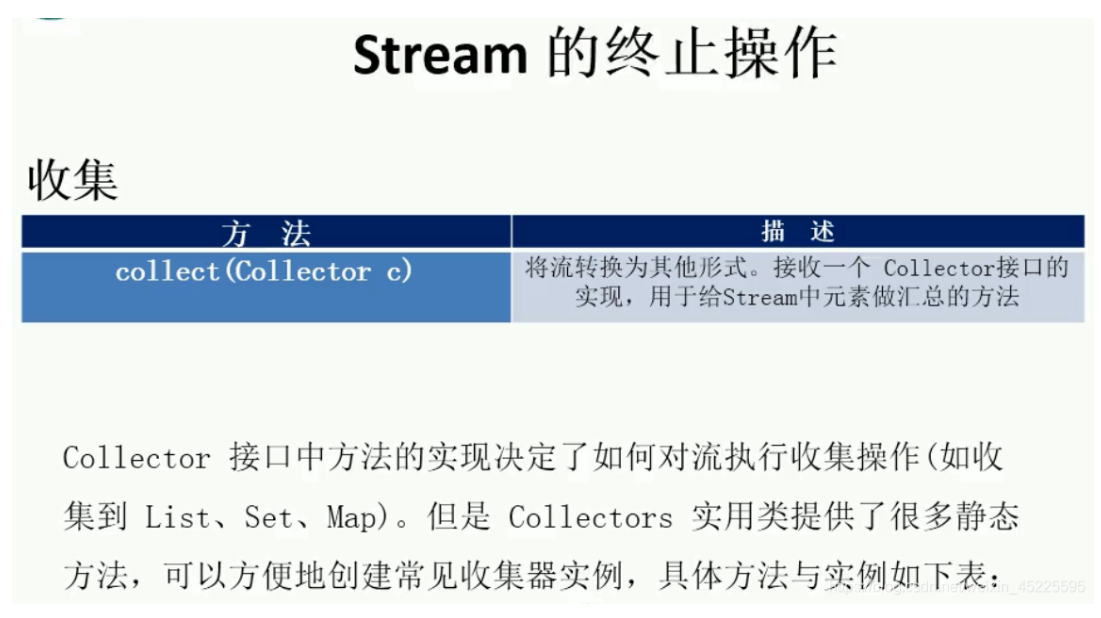
List<Employee> emps = Arrays.asList(
new Employee(101, "Z3", 19, 9999.99),
new Employee(102, "L4", 20, 7777.77),
new Employee(103, "W5", 35, 6666.66),
new Employee(104, "Tom", 44, 1111.11),
new Employee(105, "Jerry", 60, 4444.44)
);
@Test
public void test02(){
//放入List
List<String> list = emps.stream()
.map(Employee::getName)
.collect(Collectors.toList());
list.forEach(System.out::println);
//放入Set
Set<String> set = emps.stream()
.map(Employee::getName)
.collect(Collectors.toSet());
set.forEach(System.out::println);
//放入LinkedHashSet
LinkedHashSet<String> linkedHashSet = emps.stream()
.map(Employee::getName)
.collect(Collectors.toCollection(LinkedHashSet::new));
linkedHashSet.forEach(System.out::println);
}
@Test
public void test03(){
//总数
Long count = emps.stream()
.collect(Collectors.counting());
System.out.println(count);
//平均值
Double avg = emps.stream()
.collect(Collectors.averagingDouble(Employee::getSalary));
System.out.println(avg);
//总和
Double sum = emps.stream()
.collect(Collectors.summingDouble(Employee::getSalary));
System.out.println(sum);
//最大值
Optional<Employee> max = emps.stream()
.collect(Collectors.maxBy((e1, e2) -> Double.compare(e1.getSalary(), e2.getSalary())));
System.out.println(max.get());
//最小值
Optional<Double> min = emps.stream()
.map(Employee::getSalary)
.collect(Collectors.minBy(Double::compare));
System.out.println(min.get());
}
@Test
public void test04(){
//分组
Map<Integer, List<Employee>> map = emps.stream()
.collect(Collectors.groupingBy(Employee::getId));
System.out.println(map);
//多级分组
Map<Integer, Map<String, List<Employee>>> mapMap = emps.stream()
.collect(Collectors.groupingBy(Employee::getId, Collectors.groupingBy((e) -> {
if (e.getAge() > 35) {
return "开除";
} else {
return "继续加班";
}
})));
System.out.println(mapMap);
//分区
Map<Boolean, List<Employee>> listMap = emps.stream()
.collect(Collectors.partitioningBy((e) -> e.getSalary() > 4321));
System.out.println(listMap);
}
@Test
public void test05(){
//总结
DoubleSummaryStatistics dss = emps.stream()
.collect(Collectors.summarizingDouble(Employee::getSalary));
System.out.println(dss.getMax());
System.out.println(dss.getMin());
System.out.println(dss.getSum());
System.out.println(dss.getCount());
System.out.println(dss.getAverage());
//连接
String str = emps.stream()
.map(Employee::getName)
.collect(Collectors.joining("-")); //可传入分隔符
System.out.println(str);
}
1.6 案例:
**案例一:**给定一个数字列表,如何返回一个由每个数的平方构成的列表呢?(如:给定【1,2,3, 4,5】,返回【1,4,9,16,25】)
@Test
public void test01(){
List<Integer> list = Arrays.asList(1, 2, 3, 4, 5);
list.stream()
.map((x) -> x * x)
.forEach(System.out::println);
}
**案例二:**怎样使用 map 和 reduce 数一数流中有多少个 Employee 呢?
List<Employee> emps = Arrays.asList(
new Employee(101, "Z3", 19, 9999.99),
new Employee(102, "L4", 20, 7777.77),
new Employee(103, "W5", 35, 6666.66),
new Employee(104, "Tom", 44, 1111.11),
new Employee(105, "Jerry", 60, 4444.44)
);
@Test
public void test02(){
Optional<Integer> result = emps.stream()
.map((e) -> 1)
.reduce(Integer::sum);
System.out.println(result.get());
1.7:并行流:
- 并行流:就是把一个内容分成几个数据块,并用不同的线程分别处理每个数据块的流
- Java 8 中将并行进行了优化,我们可以很容易的对数据进行操作;Stream API 可以声明性地通过 parallel() 与 sequential() 在并行流与串行流之间切换
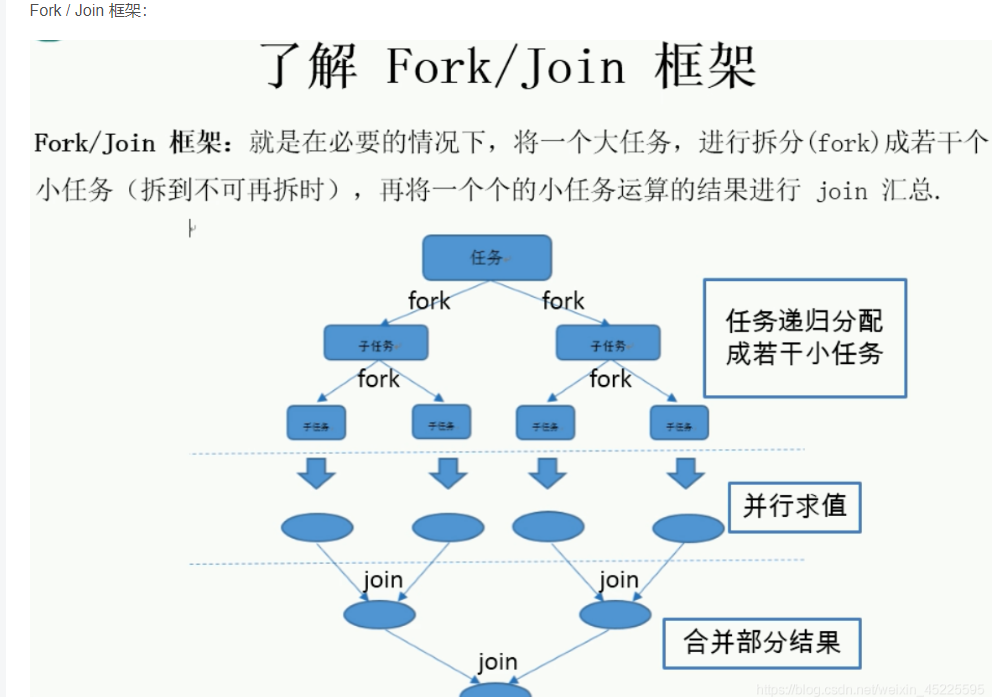
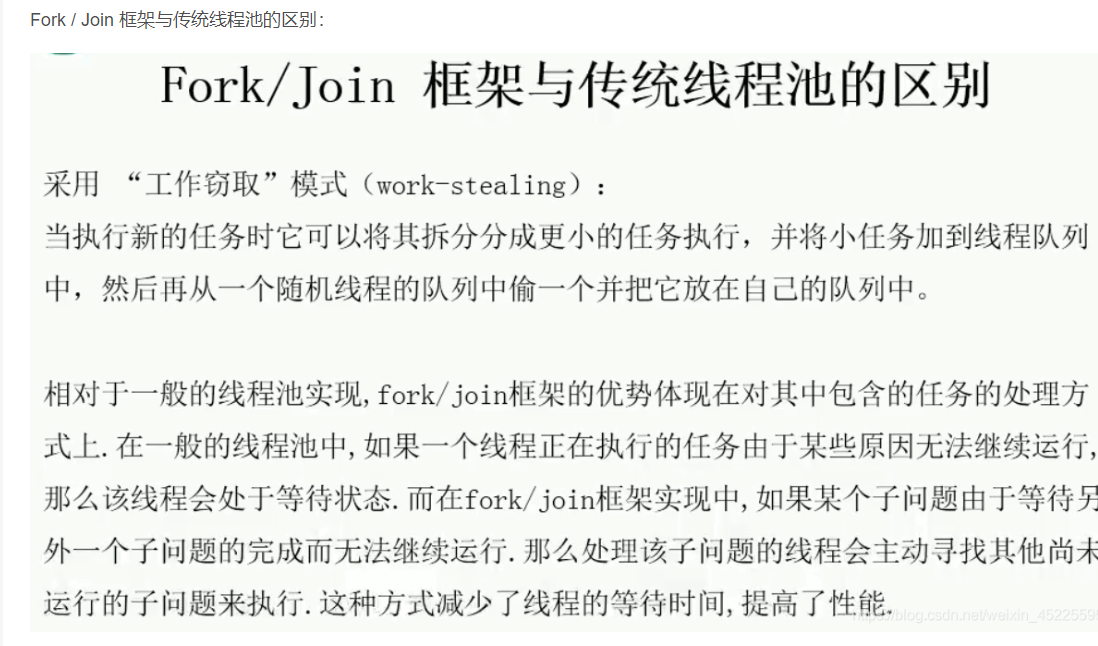
Fork / Join 实现:
public class ForkJoinCalculate extends RecursiveTask<Long> {
private static final long serialVersionUID = 1234567890L;
private long start;
private long end;
private static final long THRESHPLD = 10000;
public ForkJoinCalculate(long start, long end) {
this.start = start;
this.end = end;
}
@Override
protected Long compute() {
long length = end - start;
if (length <= THRESHPLD) {
long sum = 0;
for (long i = start; i <= end; i++) {
sum += i;
}
} else {
long middle = (start + end) / 2;
ForkJoinCalculate left = new ForkJoinCalculate(start, end);
left.fork(); //拆分子任务 压入线程队列
ForkJoinCalculate right = new ForkJoinCalculate(middle + 1, end);
right.fork();
return left.join() + right.join();
}
return null;
}
}
public class TestForkJoin {
/**
* ForkJoin 框架
*/
@Test
public void test01(){
Instant start = Instant.now();
ForkJoinPool pool = new ForkJoinPool();
ForkJoinCalculate task = new ForkJoinCalculate(0, 100000000L);
Long sum = pool.invoke(task);
System.out.println(sum);
Instant end = Instant.now();
System.out.println(Duration.between(start, end).getNano());
}
/**
* 普通 for循环
*/
@Test
public void test02(){
Instant start = Instant.now();
Long sum = 0L;
for (long i = 0; i < 100000000L; i++) {
sum += i;
}
Instant end = Instant.now();
System.out.println(Duration.between(start, end).getNano());
}
}
Java 8 并行流 / 串行流:
@Test
public void test03(){
//串行流(单线程):切换为并行流 parallel()
//并行流:切换为串行流 sequential()
LongStream.rangeClosed(0, 100000000L)
.parallel() //底层:ForkJoin
.reduce(0, Long::sum);
}